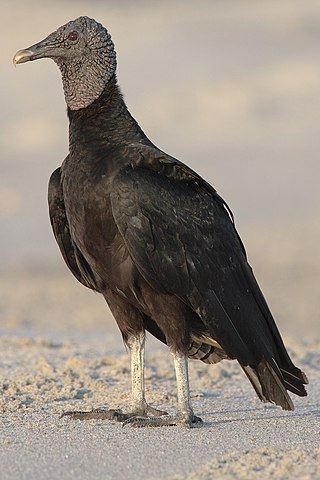
A vulture is a bird of prey that scavenges on carrion. There are 23 extant species of vulture. Old World vultures include 16 living species native to Europe, Africa, and Asia; New World vultures are restricted to North and South America and consist of seven identified species, all belonging to the Cathartidae family. A particular characteristic of many vultures is a bald, unfeathered head. This bare skin is thought to keep the head clean when feeding, and also plays an important role in thermoregulation.

The bearded vulture, also known as the lammergeier and ossifrage, is a very large bird of prey and the only member of the genus Gypaetus. Traditionally considered an Old World vulture, it actually forms a separate minor lineage of Accipitridae together with the Egyptian vulture, its closest living relative. It is not much more closely related to the Old World vultures proper than to, for example, hawks, and differs from the former by its feathered neck. Although dissimilar, the Egyptian and bearded vulture each have a lozenge-shaped tail—unusual among birds of prey. It is vernacularly known as Homa, a divine bird in Iranian mythology.
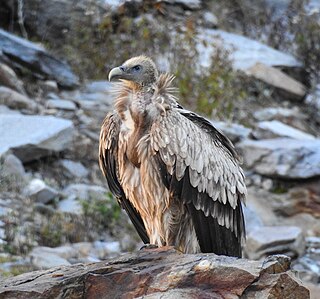
The Himalayan vulture or Himalayan griffon vulture is an Old World vulture native to the Himalayas and the adjoining Tibetan Plateau. It is one of the two largest Old World vultures and true raptors. It is listed as Near Threatened on the IUCN Red List. It is not to be confused with the Eurasian griffon vulture, which is a similar and sympatric species.

The cinereous vulture is a large raptor in the family Accipitridae and distributed through much of temperate Eurasia. It is also known as the black vulture, monk vulture and Eurasian black vulture. With a body length of 1.2 m, 3.1 m (10 ft) across the wings and a maximum weight of 14 kg (31 lb), it is the largest Old World vulture and largest member of the Accipitridae family.
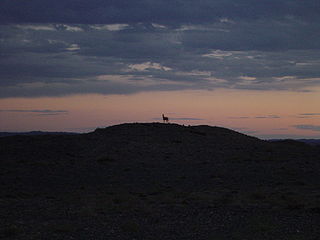
The Eastern Gobi desert steppe is a deserts and xeric shrublands ecoregion in Mongolia and northern China. It is the easternmost of the ecoregions that make up the larger Gobi Desert. It lies between the more humid Mongolian–Manchurian grassland on the north, east, and southeast, and the drier Alashan Plateau semi-desert to the west.

Circaetinae is a bird of prey subfamily which consists of a group of medium to large broad-winged species. These are mainly birds which specialise in feeding on snakes and other reptiles, which is the reason most are referred to as "snake-eagles" or "serpent-eagles". The exceptions are the bateleur, a more generalised hunter, and the Philippine eagle, which preys on mammals and birds.

The Hajigak Pass is a mountain pass of Afghanistan. It is situated at a height of 3,700 metres (12,100 ft) above sea-level in the northern part of Maidan Wardak province, connecting it with Bamyan province to the northwest. It is one of the two main routes from Kabul to Bamyan in Hazarajat, leading across the Koh-i-Baba range.
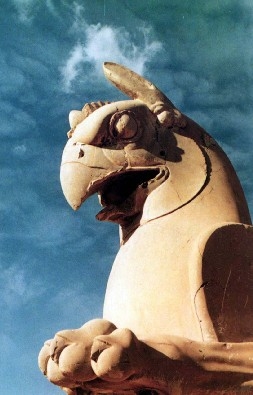
The Huma, also Homa, is a mythical bird of Iranian legends and fables, and continuing as a common motif in Sufi and Diwan poetry. Although there are many legends of the creature, common to all is that the bird is said never to alight on the ground, and instead to live its entire life flying invisibly high above the earth.
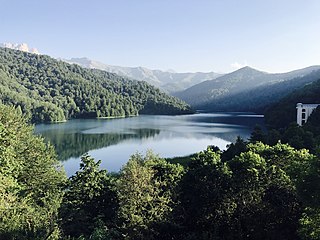
Göygöl National Park — is a national park of Azerbaijan. It was established in an area in Goygol Rayon administrative district on April 1, 2008 on the basis of the former "Goy Gol State Reserve" that was established in 1925 and which it superseded, on a surface area of 12,755 hectares (127.55 km2). It was enlarged from 6,739 hectares (67.39 km2) of the former state reserve to its current surface area as a national park.

The Southwestern Arabian montane woodlands is a xeric woodland ecoregion in the southwestern Arabian Peninsula.

The Picos de Europa National Park is a National Park in the Picos de Europa mountain range, in northern Spain. It is within the boundaries of three autonomous communities, Asturias, Cantabria and Castile and León, which are represented on the body which runs the park. The park is also a popular destination for hikers and trekkers.
Gritulu is an archaeological site in Corsica. It is located in the commune of Luri, Haute-Corse.
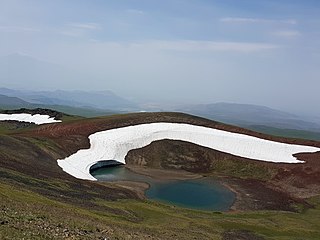
Azhdahak is a volcano in Armenia, the highest point of Gegham mountains. It has an elevation of 3,597 m above sea. It is part of the Ghegam Ridge volcanic field, which last erupted at 1900 BC ± 1000 years.
Broghil Valley National Park is located in the upper northern reaches of the Chitral District, Khyber Pakhtunkhwa, Pakistan, close to the Afghan-Pakistan border.

Ibex Cave is a limestone cave on the Rock of Gibraltar which has yielded stone artifacts of Mousterian tradition. It was discovered in 1975. It is so named as an ibex skull was found within the cave which would have been hunted by the Neanderthals of Gibraltar thousands of years ago. Ibex Cave was named and excavated by the Gibraltar Museum in 1994. Its first formal description was in 1999.
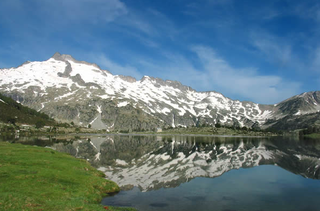
Néouvielle National Nature Reserve is a 2,313-hectare (5,720-acre) national nature reserve located in the Néouvielle massif. It ranges from 1,800 metres (5,900 ft) to 3,091 metres (10,141 ft). With a wide array of flora and fauna, it contains about 370 animal species and 570 breeds of algae.
The year 2016 in birding and ornithology.
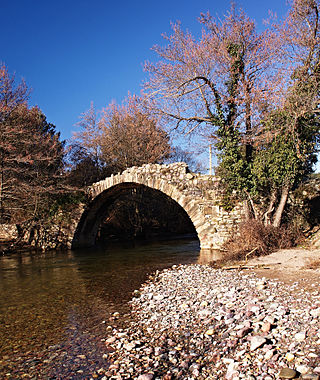
The Tartagine is a river in the department of Haute-Corse, Corsica, France. It flows through the Monte Cinto massif. It is a tributary of the Asco, which in turn is a tributary of the Golo.
Boudabousia tangfeifanii is a Gram-positive and non-spore-forming bacterium from the genus of Boudabousia which has been isolated from a rectal swabs of a vultures.
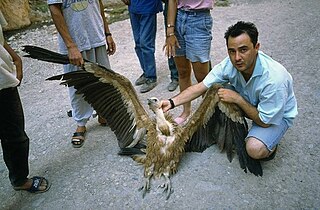
The African vulture crisis is the name given to the ongoing population decline in several Old World vulture species across Africa. Steep population declines have been reported from many locations across the continent since the early 2000s. The causes are mainly poisoning from baited animal carcasses, and the illegal trade in vulture body parts for traditional medicine. Available data suggest that the African vulture crisis may be similar in scale to the Indian vulture crisis, but more protracted and less well documented.














